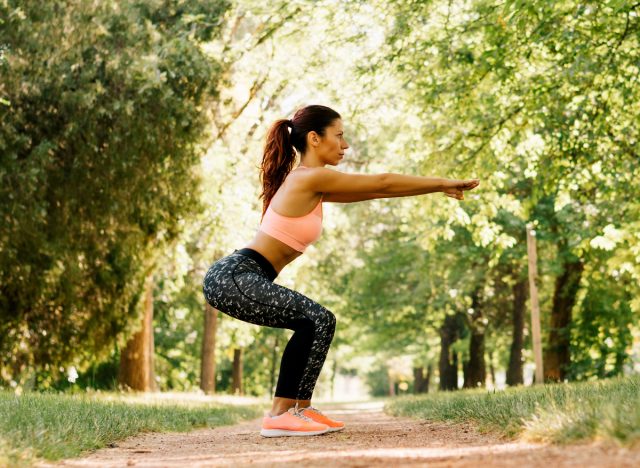How To Lose One Pound a Week Just by Walking

Losing one pound a week may sound daunting, but what if you could achieve this goal simply by incorporating walking into your daily routine? According to a 2022 study published in Nutrients, walking at any speed can support healthy weight loss when combined with a calorie deficit. This is fantastic news for those who are looking to shed some pounds without intense workout routines or restrictive diets. We spoke with Rachel MacPherson, CPT, an ACE-certified personal trainer with Garage Gym Reviews, who reveals a practical and sustainable approach regarding how to lose one pound a week by walking.
"Focus on being consistent with exercise while consuming a diet lower in calories than what you eat to keep your weight stable," MacPherson tells us. "Usually, this means cutting 250 to 500 calories per day. You can do this through a combination of diet and exercise, aiming to burn a few hundred calories per day through activity."
Walking offers more than just physical benefits. It's an opportunity to clear your mind, breathe fresh air, boost your mental health, and appreciate the world around you. Once you understand the science behind how walking influences your metabolism and calorie burn, you'll discover that this seemingly basic activity can be a game-changer in your weight loss journey.
Read on for MacPherson's tips on how to lose one pound a week by walking. And, when you're done, find out How Many Calories Are In an Apple?
Walk for 10 to 15 minutes after each meal.

Walking after meals is a simple yet effective weight loss strategy. A recent study published in Sports Medicine found that this activity aids in digestion and helps regulate blood sugar levels. Taking a quick stroll around the block can add up and contribute to your overall daily activity.
"Walk for 10 to 15 minutes after each meal and before bed or upon waking up," says MacPherson. "Walking for short periods multiple times per day, especially after you eat, helps regulate blood sugar and makes it easier to fit enough movement into your day. Getting in plenty of activity daily is more effective than doing one or two higher-intensity workouts per week."
Incorporate walk-runs to boost the calorie burn of your walks.

Incorporating short running intervals into your walks can elevate the intensity and calorie burn. It's a fantastic way to add variety to your routine and challenge your cardiovascular system.
MacPherson tells us, "Walk-runs are beginner-friendly and effectively burn more calories than walking while helping to support healthy sleep and stress levels. Sleep and stress are crucial factors for weight loss, as they put you in a better mental state for being motivated and making good choices around food and exercise."
Wear a weighted vest or weighted rucksack during walks.

Adding resistance, like a weighted vest or backpack, can increase the intensity of your walk. Added resistance is especially beneficial for building strength and burning more calories without dramatically increasing your workout time.
"Wear a weighted vest or rucksack during your walks to increase the calorie burn without adding more time or speed. You will also likely build muscle, which will boost your metabolism and help prevent muscle loss, which also slows metabolism," explains MacPherson.
Walk on an incline.

Choose routes involving hills or use a treadmill with an incline feature if possible. Walking uphill engages different muscles and increases the effort required, resulting in a more effective workout. Research points out that incline walking burns more calories than regular strolls.
"Walk on an incline on a treadmill or up hills to burn more calories than walking on a flat surface at the same speed," MacPherson suggests. "Walking on an incline can also support muscle maintenance during weight loss to keep your metabolism up. It's also lower impact than running but burns more calories than flat walking."
Add bodyweight exercises to your walk.

Integrate bodyweight exercises like lunges, squats, or simple calisthenics into your walk. Doing so will target various muscle groups, transforming your walk into a full-body workout that incinerates calories.
To incorporate bodyweight exercises into your walk, MacPherson says, "Stop every few minutes during your walk, or every half mile, if desired, and perform bodyweight exercises such as lunges, push-ups, and squats. Strength-based exercises are superior to cardio for losing weight, especially body fat instead of muscle. Combining the two is an excellent, efficient strategy for fat loss."









